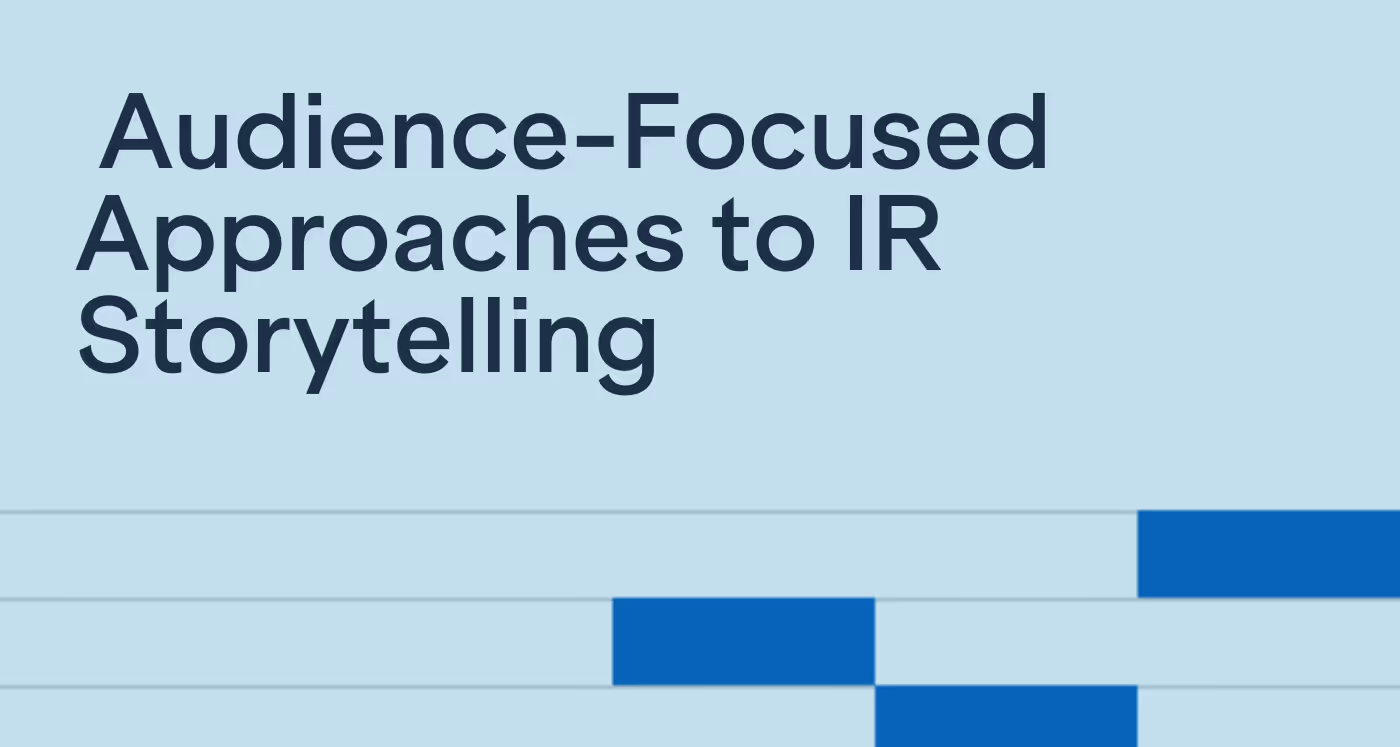
How to Build Effective Investor Targeting and Outreach Strategies for Small-Mid-Cap Companies
Learn how seasoned IR veterans are executing targeting strategies for small-mid-cap companies.

This article is part of our IR Storyteller's Handbook - Download the handbook for a practical guide to crafting and delivering investor communications that resonate.
When crafting your story, you should pay special attention to your desired audience and ensure your strategy is well-aligned with that audience. Your messaging should speak to your audience’s sophistication level and specific needs. Catering your messaging to specialized investors, generalists, analysts, or retail investors can help ensure you’re addressing the correct audience for your strategic goals.
When preparing your communications, it’s critical to know who you’re speaking to — and adjust your story accordingly. Are you addressing specialists who know your industry inside and out? Or generalists who cover multiple, often unrelated sectors?
Danielle Collins, Senior Investor Relations Director at Shell, recalls meeting an energy analyst who was headed to an alcohol and spirits conference the very next day. For her, it underscored the importance of making complex topics accessible to everyone:
“Most of the PMs and analysts you meet cover vastly different sectors. Your communication strategy has to bridge those knowledge gaps and make your story easy to understand — even for someone switching from energy to alcohol. I mean, those industries have nothing in common, but the generalist still needs to make sense of both.”
Andrew Storm, Managing Director, Investor Relations at Delta Air Lines, agrees that effective persuasion starts by meeting your audience where they are. His team prepares for detailed discussions with specialists, but always keeps the broader narrative ready for generalists:
“We prepare for the most detailed conversations — the specialists. But part of our job is helping the team remember that generalists aren’t as deep in the weeds. They just want to know the most important points to decide if they even want to enter the industry. Persuasion works best when you start where someone is, and then bring them to where you want them to be.”
By tailoring your story to your audience’s level of expertise, you make it easier for them to understand your value — and easier for them to say yes.

Analysts usually make up the most significant percentage of your audience and represent a critically important gateway to the investment community. Investors across all types of portfolios, from multibillion-dollar investment firms to retail investors, rely on reports from analysts to guide their investment decisions. The better you understand how analysts work and what they need, the stronger and more productive your relationships with them will be.
With many analysts covering dozens of companies across multiple sectors, the best thing you can provide for analysts is ease of access and information. Andrew Storm sees it as the issuer’s responsibility to help analysts focus on the right parts of the story:
“Analysts are stretched thin. They’re covering more and more, and it’s hard for them to produce high-quality thought pieces. We see it as our job to point them to the right story — to almost help them write the report by giving them what they need. They’re our megaphone, and we have to equip them to use it.”
Megan McGrath, Senior Vice President, Investor Relations at Cushman & Wakefield, agrees — drawing on her own experience on the sell-side. She recommends building key takeaways into your messaging from the start:
“Make their job easier. Know what headline you want them to write after earnings, and work that into your script. I always ask our CEO, CFO, and the team during prep: ‘What do we want the headline to be?’ Then we bake that language into our remarks. Don’t assume they’ll infer it — spell it out.”
By making it easy for analysts to get the story right, you ensure your message reaches the broader investment community loud and clear.
Another way you can be mutually helpful to analysts is to help them model your business. Zane Keller, Head of Investor Relations at Affirm, reflects on his time on the buy-side and notes that it can be difficult for analysts to model businesses accurately. He recommends hosting a walk-through session with analysts to help them understand the best ways to model your performance:
“Whether investors admit it or not, they often struggle to model your business. And this is a one-to-many problem. Do you really want to answer the same modeling question a hundred different times? Or would you rather find a scalable solution?”
Zane’s team solved this with a virtual financial model walk-through, inviting 15–20 sell-side analysts to join. They walked through a presentation, line by line, explaining how to think about modeling the business. Then they posted the replay on their IR website as an ongoing resource for new analysts and investors.
By helping analysts see your business through the lens you’ve crafted, you make it easier for them to tell the right story and strengthen the narrative you’ve worked to build.

To ensure that your storytelling is well aligned with the perception of your company, you should be aiming to get feedback from the analysts covering your sector. Andrew Storm recommends staying in touch with analysts outside of your earnings season to check in and nurture the relationship:
“For our current analysts, we try to stay in very regular touch. We try to talk with everybody right after earnings, then mid quarter, at least, and usually again just before quarter end.”
By staying engaged between earnings, you give analysts more chances to ask questions, deepen their understanding of your business, and build trust — all of which helps ensure your story is told the way you intended.
Even if retail investors are not your target audience, they’re still an important stakeholder group that should be addressed as part of your communications strategy. Research suggests that retail investors account for over 50% of global AUM, with much of it held in mutual funds. Jeffery Lambert, CEO and Founder of TiiCKER suggests that maintaining a healthy retail investor base can be beneficial due to their tendency to use consumer loyalty as a proxy for investor loyalty.
“Every retail investor is a consumer, and they are supportive of management and tend to be long-term. So we think it's the biggest unlocked audience in investor relations that exists.”
To communicate effectively with retail investors, it’s important to understand what drives them — from voting blocks and consumer loyalty to how they access and digest information.

Many issuers overlook retail investors because they assume they don’t vote — and often, they don’t. But as Jeffery Lambert points out, that’s not because they don’t care. It’s because they’re not engaged or given the right information.
Retail investors can make up a significant voting block, especially in large-cap companies. Jeffery uses Disney’s recent proxy battle as an example:
“On the large-cap side, you’re talking about retail as both a voting block and a consumer block. Ignore them at your own peril. Disney reportedly spent $20–30 million to get out the retail vote during their dissident shareholder fight. They won, but with 30 plus percent retail, you better believe they spent significant dollars in getting that. So if you ignore retail until you need them, there's a major risk.”
He also notes how costly it can be for companies that fail to engage retail early — sometimes even struggling to get a quorum.
“The idea that retail investors don’t care is a misnomer. They do care — they just haven’t been invited into a relationship. About 8 in 10 retail investors vote with management. But if you don’t engage them, you risk losing their support when it counts.”
To tap into the loyalty and potential of your retail shareholders, make them feel like part of the story. Acknowledge their loyalty, keep them informed, and ensure they understand your disclosures and ballots — before you need their vote.
Retail investors are often among the most loyal shareholders a company can have — holding onto their shares longer than institutional investors. That loyalty comes from a mix of factors: less access to trading tools, less frequent portfolio churn, and a consumer mindset that ties brand loyalty to shareholder loyalty.
Jeffery Lambert explains why retail deserves more attention:
“Retail trading and ownership is at an all-time high — and it’s still growing. Retail investors have always been important, long before meme stocks. The biggest misconception is that there’s no downside to ignoring them. But they’re your most loyal audience. They respond to opportunity, brand connection, and engagement. And the technology exists now to build those relationships directly. Ignore retail investors at your own peril.”
One big reason retail investors often feel disengaged is simply lack of access to information. While it’s not practical to include them in every roadshow or institutional event, hosting digital events tailored to retail audiences can help close that gap.
Zane Keller shares how his team approaches this with quarterly virtual fireside chats:
“We started doing retail-focused investor events — quarterly fireside chats with our CFO. They’re virtual, and we rotate in media members or sell-side analysts as moderators. Most companies don’t bother addressing the retail base, but we’ve found that when we proactively engage them and take their questions, we see much stronger engagement.”
Events like these give high-engagement retail investors and smaller family offices a rare chance to ask questions and feel heard — building trust and strengthening their connection to your story.
Effective IR storytelling means tailoring your approach to each audience’s needs — while staying true to your core message. Understanding your audience’s level of sophistication and what they care about makes your communication more impactful and memorable.
Specialists vs. Generalists: Specialists expect technical depth and industry-specific detail. Generalists, on the other hand, need the big picture and accessible context. Start by preparing comprehensive materials for specialists, then distill your story into clear, high-level takeaways for generalists who cover multiple sectors.
Analysts - Your Megaphone: Analysts are your gateway to the broader investment community — but they’re stretched thin. Make their job easier by giving them clear headlines, building key takeaways into your messaging, and even helping them model your business through dedicated walk-through sessions. Keep the relationship strong with regular check-ins beyond earnings season.
Retail Investors - The Overlooked Audience: Retail investors represent over 50% of global AUM, yet they’re often overlooked. They’re loyal, long-term shareholders who tend to vote with management — when engaged. Close their information gap through dedicated digital events, clear proxy communication, and recognition of their dual role as consumers and shareholders.
Unlock more insights into successful IR storytelling.

Learn how seasoned IR veterans are executing targeting strategies for small-mid-cap companies.

Elizabeth Librizzi breaks down the secrets of buy-side corporate access to help investor relations professionals utilize buy-side firms.

What IROs Need to Know About Taking Companies Public: Insights from award winning investor relations thought leader Catherine Buan.